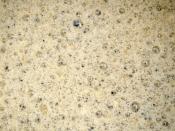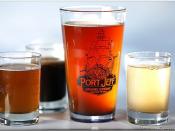The first and most important step in brewing is cleanliness. "Brewing is ninety percent janitorial," said Frederick Bowman, founder of Portland Brewing. (Bowman) The first step in the actual brewing process is malting. Malting is what is done to the barley to prepare it for brewing. The steps of the malting process release the starches that are contained in the barley, while minimizing haze and off-flavors. Grain is allowed to soak in 60ð F. water to increase the moisture content of the grain to about 40-45%. The grain is usually spread out on the floor of the germination room, or some other container. These grains are kept at a temperature of about 60ð F. The germination is complete when the sprout has grown to about 3/4 the length of the grain and the hard part of the grain, or the shell, has turned soft. The goal for germination is for the starches within the grain to break down into shorter lengths.
At this shorter length stage, the grain is called green malt. Kilning is the next stage after the grains have sprouted. Kilning is the process of drying the grain in the kiln where the temperature is slowly raised during the 30-35 hour period. After kilning, the result is finished malt, with soluble starches and developed enzymes. These grains each have a different and distinct flavor depending on how long they are cooked in the kiln. (Porter)
After the malting, the grain is ready for milling. Milling is the cracking, and crushing of the grain. This procedure is controlled carefully so as to break the grain while keeping the husk as large and as intact as possible. Milling allows the grain to absorb the water it will be mixed with later as the water will extract sugars from the malt.


